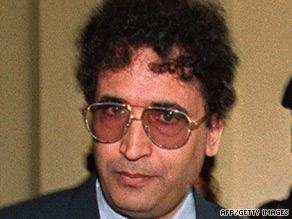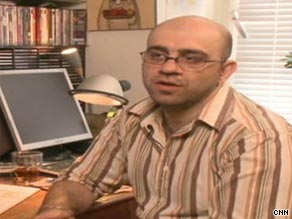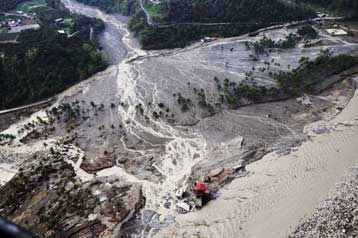| BBC - Friday, 14 August 2009 12:54 UK |
Friday, August 14, 2009
Taiwan,massive mudslide and floods ....[ 323 ]
Megrahi could be released soon.[ 322 ]
Pan Am bomber at heart of controversy since 1988
(CNN--August 14, 2009 -- Updated 0010 GMT (0810 HKT)) --
Pan Am Flight 103 was 31,000 feet in the air, heading for New York City, when it exploded over Scotland on the longest night of the year, December 21, 1988, killing 259 people on board and 11 people on the ground below.

Reports suggest that Abdelbaset Ali Mohmed al-Megrahi could be released soon.
It was the world's deadliest act of air terrorism until the September 11, 2001, attacks on New York and Washington, according to the FBI.
American and British investigators painstakingly pieced together the aircraft's wreckage and found it had been destroyed by a bomb, which they accused Abdelbaset Ali Mohmed al-Megrahi and another man of planting.
Al-Megrahi, once the security chief for Libyan Arab Airlines, and Al-Amin Khalifa Fahima were Libyan intelligence agents, the U.S. and Britain alleged in a November 1991 indictment on 270 counts of murder and conspiracy to murder.
The indictment set off a battle that lasted more than seven years.
Libya at first refused to hand the men over, prompting the U.N. Security Council in April 1992 to slap sanctions on the north African country, clamping down on arms sales and air travel.
The Federal Bureau of Investigation put the men on its 10 Most Wanted Fugitives list -- the only time officers of a foreign government have ever been named on the list, as far as the FBI knows, spokesman Ken Hoffman said.
Two years later, Libya floated the idea of trying the men in a neutral site, in an international court, which the United States and Britain rejected.
In the summer of 1998, they made a counterproposal: that the men face justice in the Netherlands under Scottish law.
By the end of the year, matters came to a head: Kofi Annan, then the secretary-general of the United Nations, met Libyan leader Moammar Gadhafi in Tripoli, Libya.
Ten days later, a U.S. Appeals Court ruled that the families of the 189 Americans killed in the attack could sue Libya for its possible role in sponsoring the attack.
Libya agreed the next day to let the men face trial.
They were handed over on April 5, 1999, to the United Nations, which suspended its sanctions the same day.
The move triggered a slow thaw in relations between the United States and Libya. Two months after the handover, American and Libyan officials met face-to-face for the first time in 18 years.
Al-Megrahi and Fahima made their first court appearances before the end of the year.
The trial lasted nine months. Al-Megrahi was convicted of the murders after prosecutors dropped lesser charges and was sentenced to at least 27 years in jail. Scotland does not have the death penalty.
Fahima was found not guilty.
Al-Megrahi has always insisted he is innocent and filed one appeal after another against his conviction. His first one was rejected in 2002.
While al-Megrahi continued to fight his sentence, the United States and Libya continued talking.
Libya agreed in 2003 to pay $2.7 billion in compensation to the families of the bombing victims, though Gadhafi always remained cagey about admitting official Libyan involvement in the bombing.
The flamboyant Libyan leader also formally renounced the pursuit of weapons of mass destruction at the end of 2003, opening the country up to nuclear inspectors after months of secret negotiations with the United States and Britain.
The United States restored full diplomatic ties with Libya in 2004, after 24 years.
In June 2007, the Scottish Criminal Cases Review Commission cleared the way for a fresh appeal by al-Megrahi, ruling that it had uncovered new evidence and that al-Megrahi "may have suffered a miscarriage of justice."
Before the appeal could be heard, however, it emerged that al-Megrahi had terminal cancer.
The appeal went ahead in April 2009, leaving al-Megrahi awaiting at least two different decisions about his fate: Will he be cleared on appeal? Will the Scottish justice minister free him on compassionate grounds because of his cancer?
And, of course, a third question also looms: Will he live long enough to find out?
Μορακότ, Μαρτύριο δίχως τέλος...[ 321 ]
Εκατοντάδες άνθρωποι θάφτηκαν ζωντανοί κάτω από τόνους λάσπης στην Ταϊβάν | ||||
| Εικόνα καταστροφής στο νότιο τμήμα της Ταϊβάν | ||||
| ||||
Bαρύτατο είναι το τίμημα που πληρώνει το χωριό Χσιαολίν της Ταϊβάν μετά το πέρασμα του τυφώνα Μορακότ. Σύμφωνα με τις Αρχές πάνω από 500 άτομα θάφτηκαν ζωντανά κάτω από τόνους λάσπης, συνέπεια των κατολισθήσεων που προκλήθηκαν «Ήδη μιλάμε για πάνω από 500 νεκρούς» δήλωσε ο πρόεδρος της χώρας. Στην περιοχή του Χσιαολίν η κατάσταση είναι δραματική, αφού εκεί που υπήρχαν σπίτια τώρα υπάρχουν μόνο ερείπια, δρόμοι έχουν μετατραπεί σε τάφρους και γέφυρες κατέρρευσαν. Συνολικά οι διασώστες έχουν απεγκλωβίσει πάνω από 14 χιλιάδες ανθρώπους. Οι Αρχές έκαναν έκκληση στη διεθνή κοινότητα για ανθρωπιστική βοήθεια. Ήδη έχουν ανταποκριθεί η Ευρωπαϊκή Ένωση και οι Ηνωμένες Πολιτείες. Ο τυφώνας Μορακότ έπληξε την Ταϊβάν, αλλά και περιοχές της Κίνας το περασμένο Σαββατοκύριακο, προκαλώντας τις χειρότερες καταστροφές των τελευταίων 50 χρόνων. Μέσα σε 48 ώρες έπεσαν 2 μέτρα βροχής, ενώ οι καταστροφές μόνο στη γεωργία ξεπερνούν τα 200 εκατομμύρια δολάρια. Newsroom ΔΟΛ | ||||
Κόσμος: Περισσότερες ειδήσεις |
The Typhoon Morakot ...[ 320 ]
Slow-Moving Typhoon Morakot Inundates Taiwan
Posted August 11, 2009
Though its winds were not particularly powerful when it made landfall in Tawian, slow-moving Typhoon Morakot soaked the southern part of the island with heavy rain between August 3 and 9, 2009. The water-soaked ground slid off the sides of mountains, generating deadly landslides. The largest slide occurred in the southern mountains of Taiwan; as of August 10, at least a hundred people were still missing.
This image of the rainfall accumulation along Morakot’s path through the western Pacific is based on estimates from the near-real-time, Multi-satellite Precipitation Analysis, which is produced by scientists at NASA’s Goddard Space Flight Center. The analysis depends on data from the Tropical Rainfall Measuring Mission satellite. Increasing storm intensity (beginning with Tropical Depression) is indicated by darker shades of red. Morakot intensified to Category 2 strength prior to landfall. Highest rainfall totals (greater than 900 millimeters, or about 34 inches) are dark blue, and they are concentrated over the mountains of southern Taiwan. According to BBC news, the flooding in Taiwan is the worst in 50 years.
See Severe Storms: Typhoon Morakot for additional images of this storm.
NASA image by Jesse Allen, using near-real-time data provided courtesy of TRMM Science Data and Information System at Goddard Space Flight Center. Caption by Rebecca Lindsey.
Wednesday, August 5, 2009
Iran militia exposed by Blogger...[ 319 ]
By Frederik Pleitgen - CNN
Berlin, Germany (CNN) -- August 5, 2009 -- Updated 0955 GMT (1755 HKT
Amir Farshad Ebrahimi sits at his computer in a small apartment in Berlin clicking through data bases with thousands of photos. He clicks back and forth between the Web and the photos of demonstrations in Iran for hours.

The pictures show plain-clothed men beating up demonstrators in Iranian cities after the disputed presidential elections. Every once in a while he circles a head, a baton or a gun.
"This is one of the guys I used to know," he says. "We were in Ansar-e Hezbollah together. I was very surprised to find him here."
Ebrahimi says he knows many of those who are now beating up demonstrators in Iran because he used to be one of them, a member of a religious militia called Ansar-e Hezbollah. His story gives an insight into the make-up and the ideology of the hard-line groups that are cracking down on demonstrators in Iran.
"None of them are police. Most of them are Basij or Ansar-e Hezbollah members. These are a series of paramilitary groups which work under the direct supervision of the leader, forces which work based on their ideology."
Don't Miss
* Special report: Iran election fallout
Ebrahimi names and shames those he recognizes on the Web. He publishes their names and phone numbers and sometimes even their addresses, "so people in their neighborhood know what they are doing."
He says some of them contact him at home and threaten to kill him, but others simply feel betrayed by their former comrade.
"One of them called me and said: 'what you are doing us unethical. You are ruining our friendship.' I told him he was acting unethically and that he has the blood of the people on his hands, I didn't talk to him any further."
Ebrahimi was a founding member of the Ansar-e Hezbollah group, which like many others has its roots in the Iran-Iraq war in the late 1980s. In 1988, when Ebrahmi was just 13 years old, he says he forged his ID and went to the frontline against Saddam Hussein's army. Video Watch more on Ebrahimi's story »
He shows us pictures of him as a young man, trying hard to look older by growing a beard, carrying a rifle or manning an anti-aircraft cannon.
"When an Iranian Basij soldier got shot right next to me, that was the first time I saw a dead body next to me. It was then I realized where I actually was and I asked myself what was I doing there anyway?"
After the war, Ebrahimi and others decided they were now the true guardians of the Islamic revolution and would defend it against Western influence.
"For example, we were opposed to the commercial advertisements of western products, we were opposed to the economic conditions, or the political conditions. So anyway we had some demands and believed we are the rightful because we said we served in the war front, we gave our life and health, not to defend a country that is being looted now the way it was. Those demands we had brought us together to start the Ansar-e Hezbollah."
Farshad rose through the ranks of the organization he says was never meant to be political or violent.
But video apparently taken at a recent demonstration and posted on YouTube showed Iranian protesters chanting "Mojtaba Die!"
"Mojtaba" is Mojtaba Khamenei, the son of Iran's Supreme leader Grand Ayatollah Ali Khamenei. Many Iranians accuse Mojtaba of leading the recent violent crackdown on protesters. Ebrahimi says he was also an early comrade of his on the battlefront.
Ebrahimi says he and Mojtaba spent a lot of time together. "He was a good kid, we were really good friends, and you could also truly say he also liked violence."
Over time, Ansar-e Hezbollah grew and Ebrahimi became the managing editor of the group's own newspaper. He says he quit the organization in 1999 when Ansar-e Hezbollah used violence against students during the uprising which was brutally cut down by security forces that year. "We went to a dorm and they started beating up people. That was when I took the microphone and said: 'No, Ansar-e Hezbollah is wrong, you the students are right."
Since then, Ebrahimi has become a fugitive. He was jailed in Iran then fled to Turkey and Germany where he got married and lives today. He says he was taken into custody by Turkish security forces and interrogated by the Iranian secret service who threatened to bring him back to the country.
advertisement
He uses his computer, his blog and twitter to spread the information about those he says are beating up the protesters.
"When I last looked somewhere between seven to eight thousand people had visited my site and read the information, so this site has in a way turned into a reference source."




